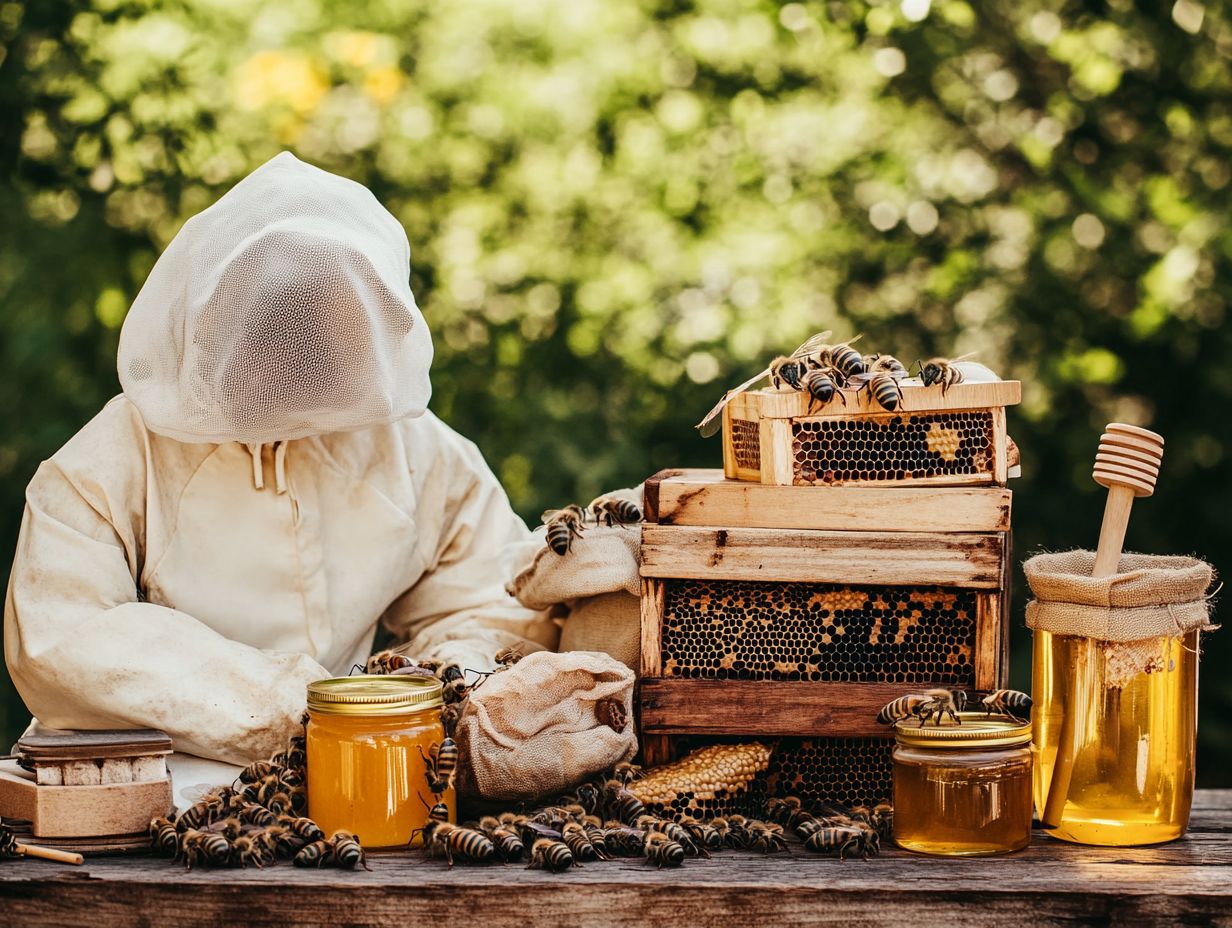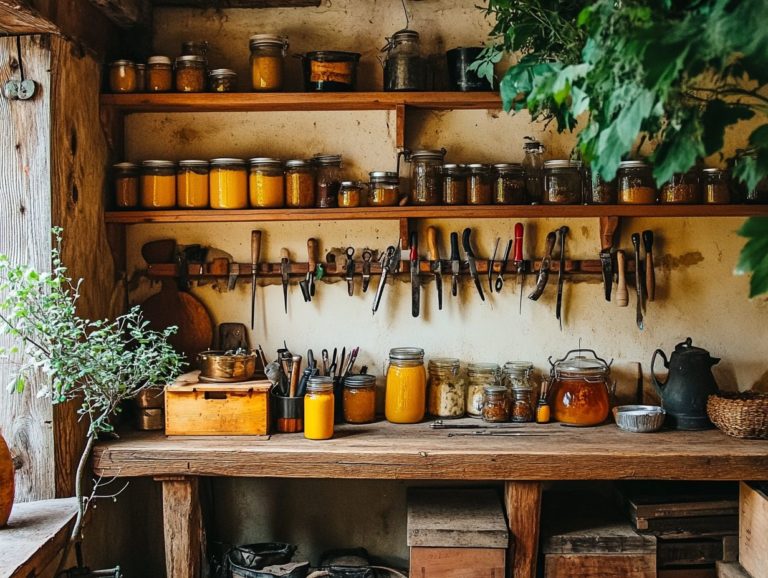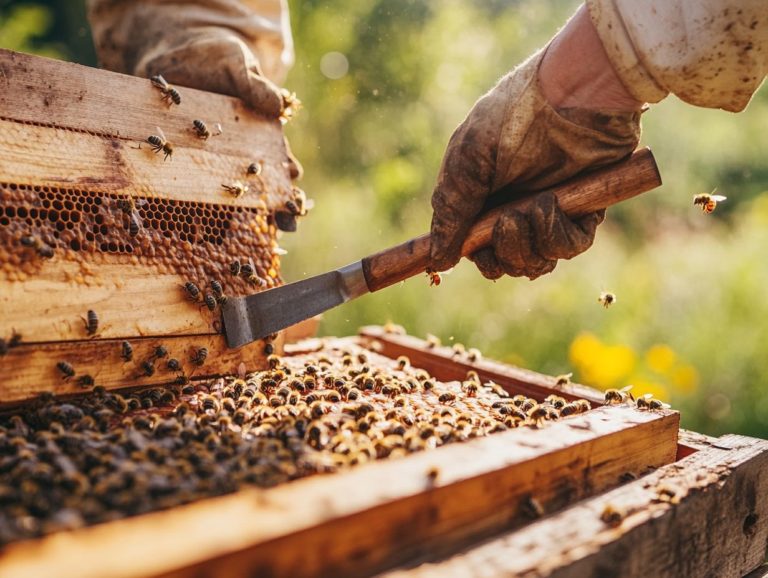Top 7 Beekeeping Accessories You Didn’t Know You Need
Beekeeping is a truly rewarding endeavor. Possessing the right tools can significantly influence both your success and safety.
Whether you’re a seasoned apiarist or just embarking on this journey, grasping the essential accessories can elevate your beekeeping experience.
From protective clothing to specialized tools like honey extractors and uncapping knives, each item serves a vital role in effective hive management.
Discover the top seven beekeeping accessories you never knew you needed—transform your beekeeping experience today!
Contents
- Key Takeaways:
- 1. Protective Clothing
- 2. Smoker
- 3. Hive Tool
- 4. Queen Excluder
- 5. Honey Extractor
- 6. Uncapping Knife
- 7. Pollen Trap
- Why Are These Accessories Important for Beekeepers?
- How Do These Accessories Help with Beekeeping Tasks?
- What Are the Different Types of Protective Clothing for Beekeeping?
- How Does a Smoker Help with Beekeeping?
- What Are the Different Types of Hive Tools and Their Uses?
- Why Is a Queen Excluder Necessary for Beekeeping?
- What Are the Different Types of Honey Extractors and Their Benefits?
- How Can an Uncapping Knife Improve the Honey Extraction Process?
- What Are the Benefits of Using a Pollen Trap in Beekeeping?
- Frequently Asked Questions
Key Takeaways:
- Protective clothing shields you from stings and hazards!
- A smoker calms the bees, making inspections smoother!
- Hive tools make it easy to manage your bee colony!
1. Protective Clothing
Protective clothing is essential for you as a beekeeper, especially if you’re just starting out. Your safety while managing a hive is paramount. This specialized clothing helps reduce the likelihood of bee stings, offering both comfort and security during inspections and honey harvesting.
There are various types of protective gear designed to enhance this critical aspect of beekeeping. Beekeeping suits cover your entire body, creating a barrier between you and the bees. Gloves are vital, too, as they protect your sensitive hands from stings.
Don’t underestimate the importance of hats with veils. They shield your face and neck, which are often prime targets during swarming. By investing in these protective items, you can lower your risk of stings, making your beekeeping experience safer and more enjoyable.
2. Smoker
The hive smoker is an essential tool in your beekeeping toolkit. It soothes bees during hive inspections and honey harvesting. By generating smoke from natural materials like wood pellets, it creates a protective environment that allows you to work safely.
This calming effect is crucial during inspections, as bee agitation can trigger defensive behavior. You’ll find a variety of smoker fuels at your disposal, including pine needles, burlap, and cardboard.
Using a smoker ensures a safer interaction with the bees and facilitates smoother honey extraction by minimizing any frenzy. To effectively apply smoke, gently puff at the entrance and into the hive frames for an even distribution.
3. Hive Tool
A hive tool is an essential accessory for you as a beekeeper, especially if you’re managing a Langstroth hive. This versatile tool helps you pry apart hive boxes, lift frames, and scrape away propolis, making it vital for keeping your bee colonies healthy.
Your efficiency in hive management becomes significantly enhanced with various types of hive tools at your disposal, including the standard hive tool, frame grip, and bee brush. Each type serves a unique function, whether it’s gently handling bees or ensuring the seamless separation of frames during inspections.
With the right hive tool in hand, you can navigate hive management tasks with ease. This ultimately allows your operations to run more smoothly and ensures that your colonies thrive without unnecessary disruptions.
4. Queen Excluder
A queen excluder is an essential tool for beekeepers managing colonies during honey harvesting. This specialized grid allows worker bees to pass through while keeping the queen bee out of the honey supers, ensuring a pure honey yield.
Maintaining this separation preserves the quality and integrity of your honey, preventing brood from contaminating valuable honey stores. By using a queen excluder, you can streamline harvesting, making it more efficient and less labor-intensive.
Various types of queen excluders are available—wooden, plastic, and metal—each with unique benefits and challenges. In situations like spring honey flows or late-season harvesting, these devices are essential for managing space and dedicating the honeycomb solely to honey production.
In hive management, queen excluders enhance productivity while protecting against issues like overpopulation and brood diseases.
5. Honey Extractor
The honey extractor is a vital piece of equipment in your beekeeping toolkit, especially during the honey harvesting season. This device extracts honey from hive frames without damaging the comb, ensuring both honey and your bee colony remain intact.
Honey extractors use spinning motion to work, coming in two primary varieties: manual and electric. Manual extractors are perfect for small-scale operations or hobbyists, while electric models cater to larger apiaries with a focus on efficiency and speed.
Both types spin the frames, creating a force that pushes honey through the mesh and collects it below. Extractors maximize your honey yield while minimizing stress on the bees, making them essential for your beekeeping kit. Their efficiency allows quick honey harvesting while maintaining the health and vitality of your colonies.
6. Uncapping Knife
An uncapping knife is essential for beekeepers during honey harvesting, specifically designed to remove wax caps from honeycombs. This step is crucial for accessing the delicious honey stored within the frames, paving the way for seamless extraction.
You can choose between electric and manual uncapping knives based on your preferences. Electric knives heat quickly for efficient use, while manual knives provide a satisfying traditional experience.
Both types feature distinct characteristics, such as ergonomic handles and various blade shapes, enhancing control and comfort while working. Mastering these tools—whether ensuring proper temperatures for electric knives or applying steady pressure with manual ones—can significantly improve your honey extraction process.
Effectively incorporating an uncapping knife into your setup is crucial for maximizing yield and ensuring top-notch quality.
7. Pollen Trap
A pollen trap is a must-have for any beekeeper eager to collect pollen from their hives. This collected pollen serves multiple purposes, from nutritional supplements for the bees to enhancing honey bee feeders.
By placing the trap strategically at the hive entrance, you can gather pollen without interfering with the colony’s natural foraging habits. This approach bolsters the health of individual bees and boosts the overall productivity of your hive.
The pollen you collect is a protein-rich food source, essential for brood development and adult nutrition, especially during lean times when natural foraging opportunities are limited.
You’ll find various types of pollen traps on the market, ranging from simple mesh designs to more intricate funnel systems, each offering its unique benefits. To maximize your results, keep an eye on the amount collected to ensure it doesn’t hinder the bees’ access to critical resources.
Pollen plays a crucial role in our ecosystem, aiding in plant pollination and maintaining a variety of life in the world. By wisely utilizing this resource, you not only enhance the health of your hive but also contribute to environmental sustainability.
Why Are These Accessories Important for Beekeepers?
The essential accessories of beekeeping—think protective clothing, hive tools, and honey extractors—are pivotal for your success and safety, whether you’re just starting out or you’re a seasoned pro.
Using the right supplies makes hive management more effective while promoting the health and productivity of your bee colonies. This is crucial for anyone involved in this rewarding practice.
As a beginner stepping into this fascinating world, proper equipment is your gateway to understanding hive dynamics while keeping sting risks at bay. Protective clothing, like veils and gloves, ensures your safety during inspections.
Tools such as smokers and scrapers make it easier to access vital areas within the hive. Honey extractors streamline your harvesting process, preserving the quality of your honey and saving you from wasted effort.
Joining beekeeping clubs provides you with a wealth of collective knowledge and shared resources. It also fosters a community spirit that encourages learning and sustainability in this vital endeavor.
How Do These Accessories Help with Beekeeping Tasks?
The range of accessories available to you as a beekeeper greatly enhances the efficiency and safety of your tasks.
Each tool is meticulously designed to meet specific needs, allowing you to effectively manage your colonies while minimizing the risks of bee stings and hive disturbances.
Using a smoker soothes the bees, making hive inspections smoother and less chaotic, enabling a thorough examination of the colony’s health.
A hive tool is handy for lifting frames and scraping off excess wax, simplifying the task of checking for disease or pests.
When it’s time for honey extraction, investing in a quality honey extractor ensures the process is quick and efficient, preserving the integrity of your honey and minimizing waste.
Ultimately, understanding and utilizing these specialized tools, like various types of honey extractors and frame holders, lays the groundwork for successful and sustainable beekeeping practices.
Don’t miss out on the chance to enhance your hive’s health—explore these accessories today!
What Are the Different Types of Protective Clothing for Beekeeping?
Protective clothing for beekeeping is available in a variety of types, each crafted to provide safety and comfort while you work with bees. Whether you opt for a full beekeeping suit, gloves, or veils, these garments are essential for minimizing the risk of stings and ensuring a positive experience, whether you’re a novice or a seasoned pro.
These outfits frequently feature lightweight, breathable fabrics that allow for excellent ventilation while still offering a reliable barrier against stings. Full suits typically come equipped with elastic cuffs and high collars to ensure maximum coverage, leaving no skin exposed.
Gloves vary in materials, from leather to heavy-duty fabric, each providing different levels of dexterity and protection.
Veils, crucial for safeguarding your face, come in a range of styles — from simple hoods to integrated helmets. When selecting your attire, consider local bee behaviors alongside your personal comfort and preferences to ensure the safest and most enjoyable beekeeping experience possible.
How Does a Smoker Help with Beekeeping?
A smoker is an essential tool in your beekeeping arsenal, specifically crafted to help you manage bee behavior during hive inspections and honey extraction. Using specialized bee smoker fuel, like smoker pellets, generates smoke that calms the bees, significantly lowering the risk of stings and creating a safer working environment.
The magic behind this calming effect lies in the smoke’s ability to mask alarm pheromones, which are substances bees release when they feel threatened. As a result, the bees become less aggressive, allowing you to work more efficiently and with greater confidence.
To ensure your smoker operates at its best, it’s vital to maintain and use it correctly. Regularly clean the smoker body and make sure the fuel chamber is free of any residue. This maintenance will enhance your overall beekeeping experience and ensure you have a reliable tool for managing your bees.
In terms of fuels, you’ll want to stick to natural materials like:
- Wood chips – create a steady smoke
- Pine needles – burn slowly and provide consistent output
- Cotton rags – ignite easily and produce good smoke
These options will provide a consistent smoke output, which is crucial for effective hive management.
What Are the Different Types of Hive Tools and Their Uses?
Hive tools represent a diverse array of equipment essential for effective hive management. Each tool is carefully made for specific tasks that ensure your beekeeping operation runs smoothly. You’ll find essentials like frame lifters for effortlessly removing bee hive frames, beekeeping brushes for gently relocating bees, and scraping tools for tidying up wax scrapings and propolis, a sticky substance bees use to seal their hives.
Specialized tools like the smoker are invaluable, as they help sedate bees for easier handling. Hive mallets provide stability during inspections. Each tool you employ serves a crucial function, from enhancing safety during hive inspections to maintaining overall cleanliness, enabling you to manage your colonies with finesse.
Mastering the use of these tools not only streamlines your beekeeping process but also fosters the health and efficiency of your hive. This, in turn, leads to improved honey production and stronger colonies, elevating your beekeeping experience to new heights.
Try these tips today to enhance your beekeeping experience!
Why Is a Queen Excluder Necessary for Beekeeping?
A queen excluder is an essential tool for you as a beekeeper. It allows you to separate the queen from the honey-producing areas of the hive. This separation ensures the purity of the honey you extract, resulting in better honey. By preventing the queen from laying eggs in the honey supers, you can confidently harvest honey without the risk of contamination.
This separation also safeguards your honey’s quality and boosts your overall production efficiency. The excluder acts as a barrier made of slotted material, enabling worker bees to pass through while effectively blocking the larger queen. This ensures that the brood—the young bees in the hive—remains in the lower hive bodies.
For instance, during honey flows in late summer, a queen excluder lets you seize a pristine harvest, free from any larvae! In situations where your colony is experiencing a growth spurt, this tool helps manage hive space. It directs the bees’ energy toward honey production instead of brood rearing.
What Are the Different Types of Honey Extractors and Their Benefits?
Honey extractors come in various types, each offering distinct advantages tailored to your beekeeping needs and operation scale. Whether you’re a novice looking for a cost-effective manual extractor or an experienced beekeeper ready to invest in an electric model that simplifies the honey harvesting process, understanding your options can significantly boost both efficiency and yield.
If you’re managing smaller hives or just starting your beekeeping journey, a manual extractor is often your best bet. These hand-cranked devices are lightweight and portable, making them a breeze to use in the field.
On the other hand, if you’re focused on scaling up your honey production, electric extractors can handle larger volumes, making them perfect for established beekeepers. The size of the extractor matters; larger models can accommodate more frames, allowing you to save precious time during harvests. Smaller ones offer the advantage of easier cleaning and storage.
Ultimately, selecting the right extractor boils down to your specific needs, including hive size and production goals. Consider the type of beekeeping kits you may need to ensure that your investment aligns seamlessly with your beekeeping journey.
How Can an Uncapping Knife Improve the Honey Extraction Process?
An uncapping knife dramatically enhances your honey extraction process by efficiently removing the wax caps from honeycombs. This gives you easy access to the honey stored within, allowing you to extract honey without damaging the comb. This ensures both the quality of the honey and the integrity of your hive remain intact.
You have various uncapping knives at your disposal, ranging from electric to manual options. Each type offers unique features tailored to meet different beekeepers’ needs. Electric uncapping knives heat up quickly and glide effortlessly through the wax. Manual versions may require more effort but are often more portable.
Regardless of your choice, every type is designed to maximize efficiency and minimize honey waste during extraction. By employing the right uncapping technique—whether you opt for a gentle sawing motion or a swift slice—you can optimize your harvest while keeping the honeycomb intact for future use. This approach ultimately enhances the overall sustainability of your apiary.
What Are the Benefits of Using a Pollen Trap in Beekeeping?
Using a pollen trap in your beekeeping practice offers many benefits. It allows you to collect valuable pollen that can supplement your honey bee feeders and promote overall bee health. This accessory gathers pollen without disrupting the natural foraging behaviors of your bees.
Incorporating a pollen trap enhances the nutritional intake of your hives. Pollen is packed with proteins, vitamins, and minerals. These nutrients are essential for fostering healthy bee colonies. By employing best practices, such as frequently cleaning the trap and monitoring the variety of pollen collected, you’ll enjoy prolific harvests of this superfood, which can support your bees throughout the changing seasons.
To effectively install a pollen trap, ensure that it’s positioned at the entrance of the hive for easy access by the bees. Regular inspections will help optimize pollen collection while minimizing disturbance.
Frequently Asked Questions
What are the top 7 beekeeping accessories that I may not know I need?
The top 7 beekeeping accessories that you may not know you need are: a beekeeping suit, a smoker, a bee brush, a hive tool, a queen excluder, a frame grip, and a honey extractor.
What is a beekeeping suit?
A beekeeping suit is necessary to protect yourself from bee stings while working with the hive. It provides full coverage to prevent bees from entering your clothes and stinging you.
What is the purpose of a smoker in beekeeping?
A smoker calms the bees, making them less aggressive during hive inspections. It masks the pheromones that bees release when they feel threatened, easing your work with them.
Do I really need a bee brush?
Yes, a bee brush is essential. It gently moves bees off frames or surfaces without harming them.
What is a hive tool?
A hive tool is a multifunctional implement that helps you open hives, scrape excess wax, and remove frames for inspection. It’s essential for effective beekeeping.
What is the purpose of a queen excluder?
A queen excluder is a mesh barrier placed between the brood box and honey supers. It allows worker bees to pass through to store honey while keeping the larger queen from laying eggs in those supers.
Why do I need a honey extractor?
A honey extractor extracts honey from frames without damaging them. This method is much more efficient and less messy than manually extracting honey from the comb.
Start enhancing your beekeeping experience today with these essential tools!










